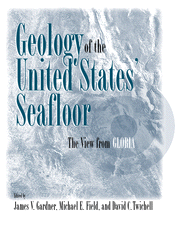Book contents
- Frontmatter
- Contents
- Contributors
- Foreword
- Introduction
- Part I The GLORIA System and Data Processing
- Part II U. S. East Coast EEZ
- Part III Gulf of Mexico and Caribbean EEZ
- Part IV U. S. West Coast EEZ
- Introduction
- 10 Discrimination of Fluid Seeps on the Convergent Oregon Continental Margin with GLORIA Imagery
- 11 A Meandering Channel at the Base of the Gorda Escarpment
- 12 The Morphology, Processes, and Evolution of Monterey Fan: A Revisit
- 13 Ground-Truth Studies of West Coast and Gulf of Mexico Submarine Fans
- 14 Morphology of Small Submarine Fans, Inner California Continental Borderland
- Part V Alaskan EEZ
- Index
Introduction
Published online by Cambridge University Press: 25 January 2010
- Frontmatter
- Contents
- Contributors
- Foreword
- Introduction
- Part I The GLORIA System and Data Processing
- Part II U. S. East Coast EEZ
- Part III Gulf of Mexico and Caribbean EEZ
- Part IV U. S. West Coast EEZ
- Introduction
- 10 Discrimination of Fluid Seeps on the Convergent Oregon Continental Margin with GLORIA Imagery
- 11 A Meandering Channel at the Base of the Gorda Escarpment
- 12 The Morphology, Processes, and Evolution of Monterey Fan: A Revisit
- 13 Ground-Truth Studies of West Coast and Gulf of Mexico Submarine Fans
- 14 Morphology of Small Submarine Fans, Inner California Continental Borderland
- Part V Alaskan EEZ
- Index
Summary
The initial USGS EEZ-SCAN surveys began in the Spring of 1984 in San Diego, California, and systematically surveyed northwards to the Canadian-U.S. border, then transited south to finish 100 days later in San Diego. These surveys mapped more than 750,000 km2 of the U.S. West Coast EEZ with a series of tracklines spaced about 30 km apart. The mapping included digital GLORIA images, 160-in3 airgun and 3.5-kHz seismic-reflection profiling, 10-kHz bathymetry, and magnetics data.
Studies of the Pacific EEZ in this volume are diversified in approach, topic, and area of investigation. They range in scale from huge areas, such as the reexamination of Monterey Fan, to small individual features such as the meandering channel north of Mendocino Fracture Zone. This diversity reflects the tectonic and sedimentary diversity that characterizes the Pacific margin.
The entire region is one of continued tectonic change, from the Miocene Plate interactions and subsequent transformation of the California margin to the formation and continued deformation of the young borderland basins of southern California to the presently active Cascadia Subduction Zone off northern California, Oregon, and Washington. The EEZ off California, Oregon, and Washington can be divided at ∼ 40° N into a northern province dominated by major tectonic ridges and fracture zones, with large sedimentary overprints, and a southern province dominated by a pattern of long-term sedimentation over an older terrain of seamounts (Figure IV–1). The northern province includes the Gorda-Juan de Fuca Ridge and associated Blanco and Mendocino Fracture Zones and the Cascadia Subduction Zone.
- Type
- Chapter
- Information
- Geology of the United States' SeafloorThe View from GLORIA, pp. 165 - 168Publisher: Cambridge University PressPrint publication year: 1996



